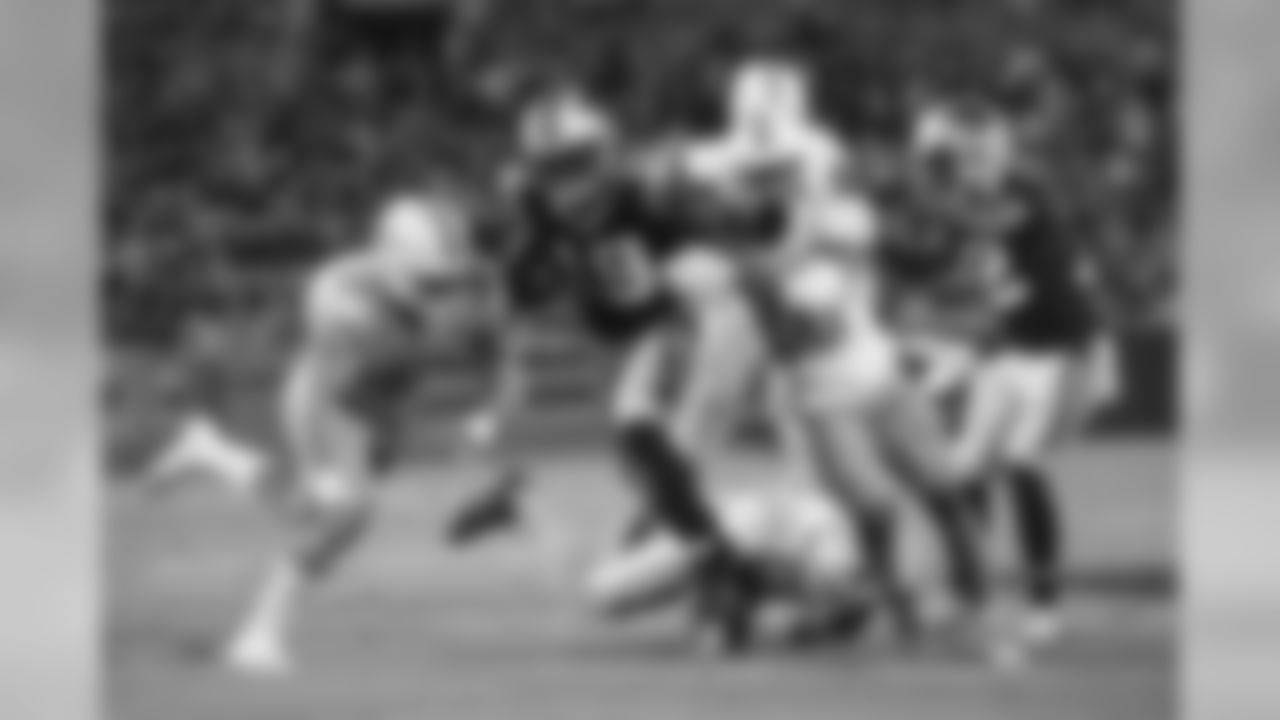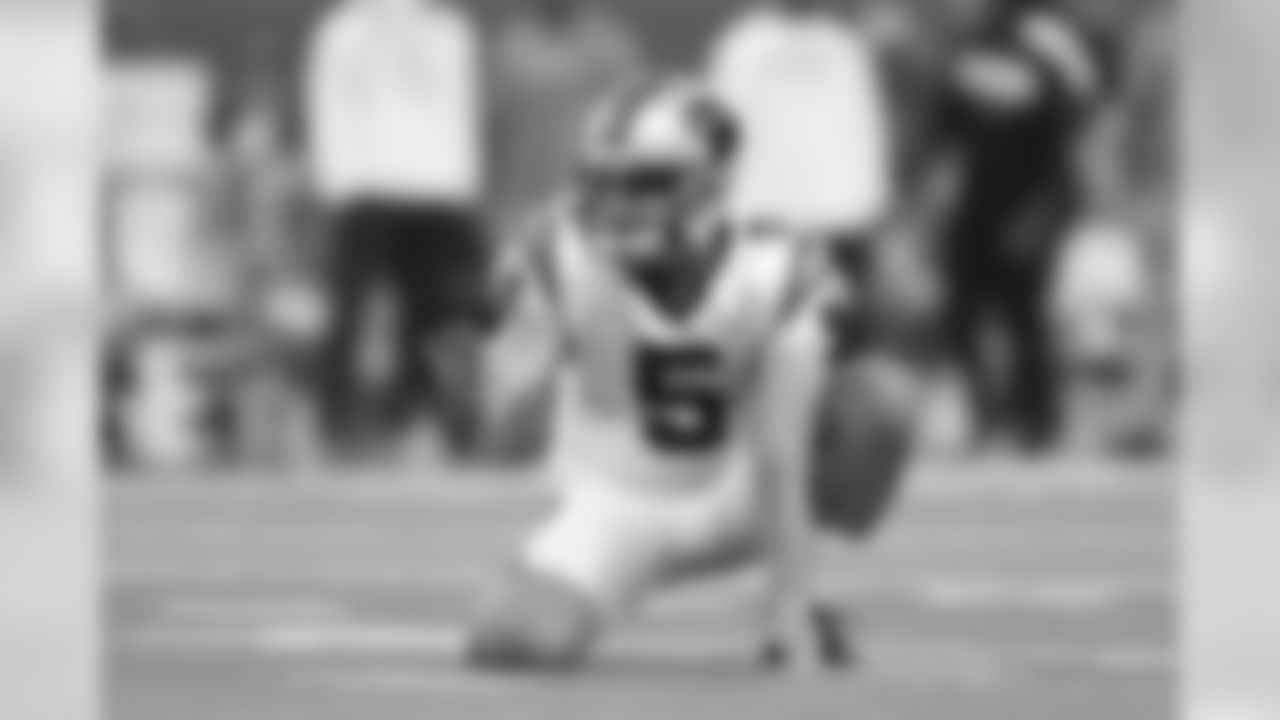A look at the Panthers' projected starters, according to the team's website.

QB Cam Newton

QB Cam Newton

QB Cam Newton

RB Jonathan Stewart

RB Jonathan Stewart

RB Jonathan Stewart

FB Alex Armah

FB Alex Armah

FB Alex Armah

WR Devin Funchess

WR Devin Funchess

WR Devin Funchess

WR Russell Shepard

WR Russell Shepard

WR Russell Shepard

TE Greg Olsen

TE Greg Olsen

TE Greg Olsen

C Ryan Kalil

C Ryan Kalil

C Ryan Kalil

G Andrew Norwell

G Andrew Norwell

G Andrew Norwell

G Trai Turner

G Trai Turner

G Trai Turner

OT Daryl Williams

OT Daryl Williams

OT Daryl Williams

OT Matt Kalil

OT Matt Kalil

OT Matt Kalil

DE Charles Johnson

DE Charles Johnson

DE Charles Johnson

DT Kawann Short

DT Kawann Short

DT Kawann Short

DE Mario Addison

DE Mario Addison

DE Mario Addison

DT Star Lotulelei

DT Star Lotulelei

DT Star Lotulelei

LB Shaq Thompson

LB Shaq Thompson

LB Shaq Thompson

LB Luke Kuechly

LB Luke Kuechly

LB Luke Kuechly

LB David Mayo

LB David Mayo

LB David Mayo

CB James Bradberry

CB James Bradberry

CB James Bradberry

CB Daryl Worley

CB Daryl Worley

CB Daryl Worley

S Kurt Coleman

S Kurt Coleman

S Kurt Coleman

S Mike Adams

S Mike Adams

S Mike Adams

K Graham Gano

K Graham Gano

K Graham Gano

P Michael Palardy

P Michael Palardy

P Michael Palardy

KR Fozzy Whittaker

KR Fozzy Whittaker

KR Fozzy Whittaker

PR Christian McCaffrey

PR Christian McCaffrey

PR Christian McCaffrey

LS J.J. Jansen

LS J.J. Jansen

LS J.J. Jansen
On Sunday, the 2-4 Tampa Bay Buccaneers get a belated start to divisional play when the 4-3 Carolina Panthers come to town. It will be the 34th meeting between the two teams in the regular season and a chance for the Buccaneers to make a move in the crowded NFC South race (more on the Bucs-Panthers series history).
Tampa Bay comes into its first intra-divisional match up of 2017 with a 2-4 record, two games behind the first-place New Orleans Saints. A trip to New Orleans looms in Week Nine, giving the Buccaneers a very real chance to quickly gain ground after three very close losses in a row. Before concerning themselves with the Saints, however, the Buccaneers need to conquer the Panthers, who feature the NFL's third-ranked defense and one of the NFL's most dynamic rookies on offense.
Here's a closer look at the challenges the Buccaneers will face when they take on the Panthers on Sunday.
HEAD COACH

Ron Rivera is a two-time winner of the second Associated Press NFL Coach of the Year award during his seven-year tenure at the helm of the Panthers. His first six years as Carolina's head coach included three division titles; in fact, the Panthers won three in a row from 2013-15, becoming the only team ever to repeat as NFC South champions. That three-year run peaked in 2015 with a franchise-best 15-1 record and a trip to the Super Bowl. Overall, Carolina is 57-45-1 under Rivera in the regular season, including this year's 4-3 start, and 3-3 in the postseason.
Carolina's second chance at the Lombardi Trophy (the Panthers lost Super Bowl XXXVIII to New England after the 2003 season) did not produce a title either, as Denver prevailed in Super Bowl 50, 24-10. Nevertheless, Rivera has helped mold the Panthers into an annual contender. Since 2013, Carolina has a winning percentage of .627 in the regular season, tied for sixth best in the NFL in that span.
Rivera was a linebacker on the famous 1985 Chicago Bears Super Bowl team, which won its first 12 games, and he began his NFL coaching career in Chicago as well, in 1997. In subsequent stops in Philadelphia, Chicago again and San Diego, Rivera became known as one of the NFL's top defensive coordinators, and that eventually led to his first head coaching opportunity in Carolina. Rivera's Panther defenses haven't disappointed, finishing in the top 10 in yards allowed in four of the last five years.
Rivera's Panthers have generally formed their offensive identity around a commitment to the run. That was true in 2015, as Carolina boasted the NFL's second-ranked rushing attack and the league's second-highest percentage of running plays at 49.6%. Of course, it helps to have a quarterback who can help to that cause, and Cam Newton was the team's leading rusher in 2016. This year, the Panthers have begun to deviate from that identity a bit, as was expected after the drafting of such versatile weapons as Christian McCaffrey and Curtis Samuel.
OFFENSE

The Buccaneers are very familiar with most of Carolina's offensive core, which obviously begins with quarterback Cam Newton. Newton's mobility, size and strong arm make him a big-play threat at all times, and he's particularly troublesome near the goal line, as evidenced by his incredible career total of 51 rushing touchdowns. This year, Newton has accounted for all three of Carolina's ground scores.
Also familiar is running back Jonathan Stewart, who remains the Panthers best choice to run between the tackles. However, that facet of Carolina's offense hasn't been as effective in 2017 as in previous years, with Stewart averaging just 3.0 yards per carry on a team-high 99 totes. As a team, the Panthers rank 29th in the NFL with a per-carry mark of 3.4 yards. Perhaps as a result, or perhaps simply due to an evolving offensive strategy, Carolina has not worked as hard to establish the run first this year, ranking 26th in the NFL in percentage of first-and-10 plays that are rushes (47.6%).
The other familiar staple in Carolina's offense is prolific tight end Greg Olsen, but that won't be a factor in the first Bucs-Panthers meeting of 2017. Olsen is on injured reserve with a foot fracture and won't be eligible to be activated from that list until late November. For now, eighth-year veteran Ed Dickson has stepped up and delivered some big plays, with 325 yards and an average of 18.1 per catch, but he's not quite the same prolific weapon as Olsen, who is coming off three straight 1,000-yard campaigns.
But there is one very new element to the Panthers' offense: ninth-overall draft pick Christian McCaffrey. McCaffrey is listed as a running back but he lines up all over the formation, including in the slot and split wide. So far, McCaffrey has done more damage through the air (44 catches for 329 yards and two touchdowns) than on the ground (45 carries for 114 yards) but the Panthers are clearly looking to get him the ball in space through a wide variety of means. McCaffrey is the team's leading pass-catcher and he also handles most of the punt return duties.
The Panthers also drafted another versatile runner-receiver weapon in the second round in Ohio State's Curtis Samuel. The team hasn't yet integrated Samuel into the offense effectively, as the rookie has just two carries and five catches so far, and a swing pass in his direction last week turned into a disastrous fumble-recovery touchdown for Chicago. Still, the changing philosophy in Carolina's offense is evident. Newton's passing game in previous years was more reliant on downfield throws, but the team let deep threat Ted Ginn depart in free agency and replaced him with shifty catch-and-run plays like McCaffrey and Samuel.
The approach has certainly helped Carolina move the chains. The Panthers lead the NFL in average time of possession (33.46 per game) and have put together the second-most five-minute drives in the NFL. Carolina's 144 first downs are tied for fourth in the league and its third-down conversion rate of 44.4% is sixth-best. On the flip side, the big plays are down. One of Samuel's two carries resulted in a team-best 31-yard gain, but that's the Panthers' only carry of more than 17 yards so far. Cam Newton's completion percentage of 64.1% is by far the best of his career (he's a 58.8% passer in his career overall) but Carolina's passer rating on throws that travel more than 20 yards in the air is 46.6, third-worst in the NFL. Newton has also been sacked 22 times and Carolina's sacks-per-pass-play rate of 8.5 is ninth-worst in the NFL.
As with Jameis Winston and his elite corps of targets, Newton has done a very good job of spreading the football around. Four different players have at least 325 receiving yards already, including wide receivers Devin Funchess (31-346-3) and Kelvin Benjamin (29-436-1), one of the biggest pairs of receivers in the NFL. Those numbers represent a big step forward for Funchess, a second-round pick in 2015, as he has already tied a career high in receptions. Benjamin's numbers have him on pace to almost exactly duplicate his 2016 totals of 63 catches for 941 yards.
The strength of Carolina's offensive line is in the middle, where a pair of Pro Bowlers operate in center Ryan Kalil and right guard Trai Turner. Offensive tackle has been a problem area for the team over the last season-and-a-half, however, and the team tried to address that by bringing in their center's older brother, Matt Kalil to protect Newton's blind side. The Panthers' low per-carry average and high sack rate indicate that there have been some difficulties up front this year, and now both Ryan Kalil (neck) and Turner (knee) are dealing with injuries. Kalil, who did not practice on Wednesday, seems to be the more pressing concern.
Overall, Carolina's offense has been a little hit-or-miss this season. They've scored 23 or more points three times but finished with 13 or fewer three other teams, including a 17-3 loss in Chicago last Sunday. Turnovers and red zone inefficiency have been factors in that inconsistency. Carolina has turned it over 13 times, tied for third-most in the league, including 10 interceptions by Newton, and those giveaways have led to 50 points for the opposition, the NFL's third-highest total. In the red zone, Carolina's otherwise excellent results on third down disappear; the Panthers are converting just 18.2% of their tries in that area of the field, third-worst in the league. That has contributed to a red zone touchdown efficiency of 42.9%, tied for 28th best.
DEFENSE

Carolina has had a star-studded front seven for years and the secondary appears to be improving rapidly after a tumultuous and inconsistent 2016 season.
The strength of the Panthers' defense is its linebacking corps, which features Pro Bowlers Luke Kuechly and Thomas Davis as well as rising play-maker Shaq Thompson. They might be the most productive 4-3 trio in the NFL. Kuechly has once again missed time due to concussions this year and he is currently in the NFL's concussion protocol, but he did practice on Wednesday. The former Defensive Player of the Year is the heart and soul of Carolina's defense, equally good against the run and the pass. He is the only player in the NFL with at least 500 tackles and 10 interceptions since 2013, and he was very good against the Buccaneers last year with 17 tackles, a sack and a forced fumble. He's doing it all again this year; despite missing last week's game, Kuechly has a team-high 54 tackles to go with an interception, a forced fumble, four quarterback pressures and two passes defensed. Thompson and David are second and third in tackles and each also has two sacks and four passes defensed.
The Panthers used their first two draft picks in 2013 on the DT duo of Star Lotulelei and Kawann Short, and those two have ably been anchoring the line ever since. Short is one of the best interior pass-rushers in the NFL and he has four sacks and 11 quarterback pressures already this year. The Panthers are also getting pressure off the edges, mostly from Mario Addison and the ageless Julius Peppers. Peppers returned to Carolina this year after a six-year run through the NFC North and has been extremely productive in a limited role. Spelling fellow long-time Panther Charles Johnson in passing downs, Peppers has 6.5 sacks while playing about 50% of the snaps each game. Carolina's 24 sacks are the second-highest total in the NFL.
Pictures from the Buccaneers' practice on Wednesday.

DE William Gholston

CB Deji Olatoye

DE Marquavius Lewis

DE Darryl Tapp

DE Marquavius Lewis

TE O.J. Howard and TE Antony Auclair

Bucs practice

Bucs practice

Bucs practice

CB David Rivers

S T.J. Ward

WR Mike Evans and WR DeSean Jackson

TE Cameron Brate

DT Clinton McDonald

DT Sealver Siliga

Bucs practice

DE Will Clarke

Bucs practice

DE Channing Ward

DE Patrick O'Connor

Bucs practice

RB Jacquizz Rodgers and RB Peyton Barber

OT Donovan Smith and QB Ryan Fiztpatrick

WR DeSean Jackson

C Evan Smith

Bucs practice

QB Jameis Winston

QB Jameis Winston and HC Dirk Koetter

QB Jameis Winston

TE O.J. Howard

CB Vernon Hargreaves

CB David Rivers and WR Bernard Reedy

WR DeSean Jackson

TE O.J. Howard

K Patrick Murray

K Patrick Murray

OT Demar Dotson

OT Donovan Smith

OT Donovan Smith

OT J.R. Sweezy and DT Clinton McDonald

OT Joe Hawley and DE Channing Ward

HC Dirk Koetter

WR DeSean Jackson

CB Vernon Hargreaves

Bobo Wilson

WR Mike Evans

WR Mike Evans and S Keith Tandy

RB Peyton Barber

DT Gerald McCoy

RB Doug Martin

WR Mike Evans and CB David Rivers

RB Doug Martin

RB Doug Martin

DT Gerald McCoy

QB Ryan Griffin

Bucs practice

RB Doug Martin and CB David Rivers

WR Mike Evans
In many ways, the Panthers' strengths and weaknesses on defense have mirrored those discussed above in the offensive section. Carolina is not allowing a lot of extended drives (tied for third-lowest in the league in opponent five-minute possessions), is doing well on third down (35.2% success rate allowed, tied for ninth in the NFL) and is not allowing a lot of first downs (107, tied for third-lowest). On the other hand, they haven't forced many turnovers (one interception, three fumbles) and have been worse in the red zone than in the rest of the field. Opponents have converted 64.3% of their drives inside the Carolina 20-yard line into touchdowns, the fifth-highest percentage in the league.
Last year was a transition season for the Carolina secondary, as they rescinded the franchise tag on Pro Bowler Josh Norman and let him walk and then used three mid-round picks on cornerbacks. The best of those has proven to be James Bradberry, who has 31 tackles, a sack and a team-high five passes defensed so far this season. Bradberry and fellow 2016 draftee-slash-starter Daryl Worley (Carolina's second and third-round picks) are both 6-1 corners with the size to match up against bigger receivers like the Bucs' Mike Evans. The Panthers' starting safeties, on the other hand, are very seasoned veterans. Kurt Coleman has had his best two seasons since arriving in Carolina in 2015, with a total of 11 interceptions and 16 passes defensed in 2015-16. He's missed three games and doesn't have a pick or a pass defensed yet this year but is still a ballhawk for whom Winston must account. Adams is in his 14th season but his first in Carolina, and he's three games away from 200 in his career.
Pressure from the front has certainly helped, but Carolina's secondary has done a good job of limiting opposing passing attacks even without any turnovers (Kuechly has the Panthers' one interception). Carolina has allowed just 180.7 net passing yards per game, fourth-lowest in the NFL. There is one strange anomaly in the team's pass defense results, however – on second down specifically, opposing quarterbacks have thrown for a passer rating of 112.3. That's the worst mark in the league in that particular category.
SPECIAL TEAMS

Carolina is getting very good results from its kicking duo of punter Michael Palardy and placekicker Graham Gano, although a right knee injury for Gano could complicate issues this week. Carolina has signed former Buccaneer kicker Roberto Aguayo to its practice squad as insurance, though Gano did practice on Wednesday.
Gano has been stellar so far, making 16 of his 17 field goal tries, with his only miss coming from 55 yards out. He has missed one of 12 extra point tries, but he is also the league's best producer of touchbacks on kickoffs. Gano has forced a touchback on 31 of his 33 kicks so far (93.9%); that's up significantly from his 74.1% average of 2016.
Gano has been with the Panthers since 2012 but Palardy just arrived last year as a midseason replacement for veteran Andy Lee, who landed on injured reserve. Both Palardy and Lee went back to camp with the Panthers this year but the team ultimately chose to go with the younger player, and he has rewarded them for their confidence. Palardy has posted a gross average of 46.2 and a very good net average of 42.3, which ranks seventh in the NFL. Opposing return men have had just eight returns at 5.1 yards per clip while calling for nine fair catches.
Rookies McCaffrey and Samuel are doing most of the return work, though they haven't provided too many big plays yet. McCaffrey is averaging 7.2 yards per punt return on 18 tries while Samuel has brought out seven kickoffs at an average of 21.4 yards each.






















